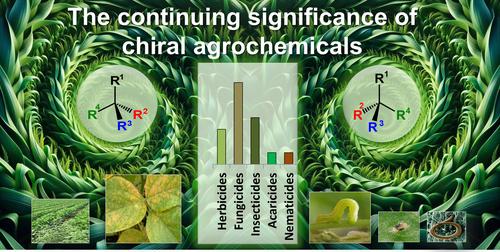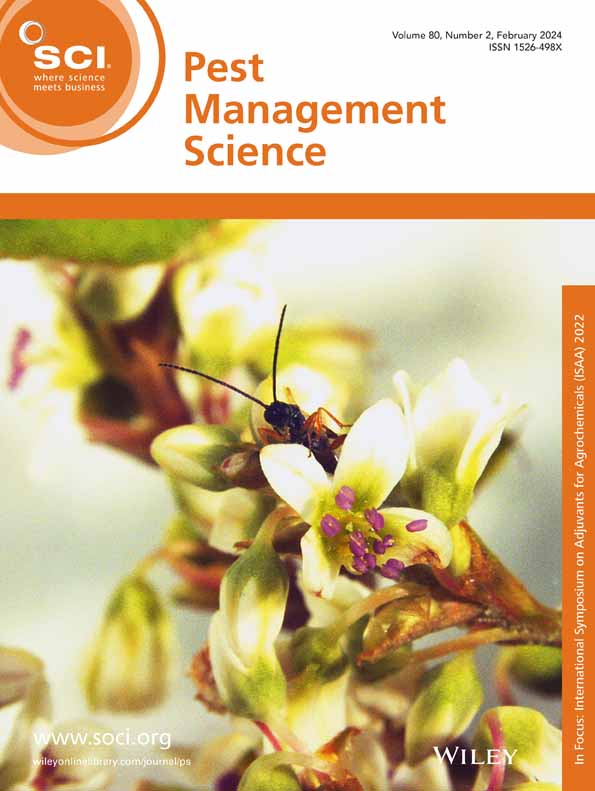手性农用化学品的持续意义
IF 3.8
1区 农林科学
Q1 AGRONOMY
引用次数: 0
摘要
化学作物保护是最具成本效益的农业方法之一,因为可以防止作物歉收,并且无论季节如何都可以实现可持续增长。未来必须大幅增加农业生产,以满足不断增长的世界人口对粮食的需求。然而,由于消费者的观念、农民不断变化的需求和不断变化的监管要求,现有活性成分的持续流失高于每年向市场推出的新活性成分。因此,创新活性成分的开发对于不断提高农用化学品的选择性、有效性和良好的环境特性至关重要。这里可以考虑具有立体中心的分子,因为它们通常具有与非手性分子不同的性质。天然产物及其同系物仍然是手性农用化学品的宝贵灵感来源。然而,目前只有少数新型手性农药以纯立体异构体或富集形式在工业规模上生产。截至2018年,在投放市场的35种手性产品(除草剂、杀菌剂、杀虫剂、杀螨剂和杀线虫剂)中,约有43%的产品在分子中含有一个或多个立体中心,其中近69%的产品以对映异构体或立体异构体的外消旋混合物的形式上市。令人惊讶的是,手性农用化学品的比例与2007年至2017年的时间框架相同,分别为42%左右。因此,本报告概述了过去6年来进入市场的手性农用化学品的持续重要性,并通过对创新作物保护产品产生的关键方面的管理描述了现代农用化学品固有的相关挑战。©2025作者。《病虫害管理科学》由John Wiley &出版;我代表化学工业协会的儿子有限公司。本文章由计算机程序翻译,如有差异,请以英文原文为准。

The continuing significance of chiral agrochemicals
Chemical crop protection is one of the most cost-effective methods for agriculture, as crop failures can be prevented, and sustainable growth can be enabled regardless of the seasons. Agricultural production must be significantly increased in the future to meet the food needs of a growing world population. However, the continued loss of established active ingredients due to consumer perceptions, changing needs of farmers and ever-changing regulatory requirements is higher than annually new active ingredients introduced to the market. The development of innovative active ingredients is therefore essential to continuously improve the selectivity, efficacy and favorable environmental profile of agrochemicals. Molecules with stereogenic centers can be considered here, as they often have different properties than non-chiral molecules. Natural products and their congeners are still a valuable source of inspiration for chiral agrochemicals. However, only a few novel chiral agrochemicals are currently produced on an industrial scale as pure stereoisomers or in enriched form. As of 2018, around 43% of the 35 chiral products introduced to the market (herbicides, fungicides, insecticides, acaricides, and nematicides) contain one or more stereogenic centers in the molecule, and almost 69% of them have been marketed as racemic mixtures of enantiomers or stereoisomers. Surprisingly, the proportion of chiral agrochemicals is in the same order of magnitude as in the time frame from 2007 to 2017 with around 42%, respectively. This report therefore provides an overview of the continued importance of chiral agrochemicals brought to market in the last 6 years and describes the inherent related challenges of modern agrochemicals through the management of key aspects arising from innovative crop protection products. © 2025 The Author(s). Pest Management Science published by John Wiley & Sons Ltd on behalf of Society of Chemical Industry.
求助全文
通过发布文献求助,成功后即可免费获取论文全文。
去求助
来源期刊

Pest Management Science
农林科学-昆虫学
CiteScore
7.90
自引率
9.80%
发文量
553
审稿时长
4.8 months
期刊介绍:
Pest Management Science is the international journal of research and development in crop protection and pest control. Since its launch in 1970, the journal has become the premier forum for papers on the discovery, application, and impact on the environment of products and strategies designed for pest management.
Published for SCI by John Wiley & Sons Ltd.
 求助内容:
求助内容: 应助结果提醒方式:
应助结果提醒方式:


